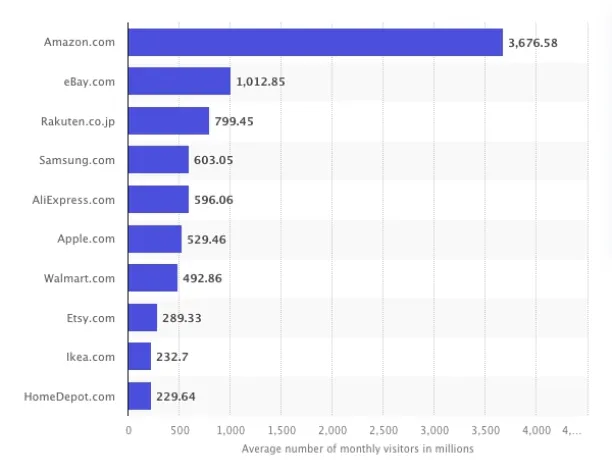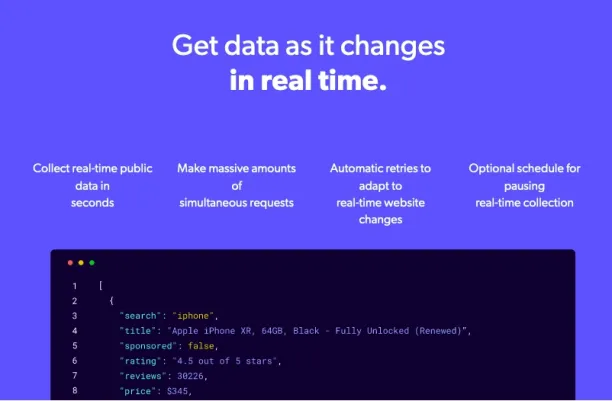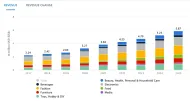The Ultimate Guide Into Digital Shelf Analytics in 2024
If you are a small Consumer Packaged Goods (CPG) company that relies on online sales, partnering with a large online retailer, such as Amazon, eBay, or AliExpress, to showcase your products would give you higher chances of visibility. And as you grow, you’d need to partner with more regional-specific retailers to infiltrate their domestic market (see Figure 1).

The problem arises when your partnerships, product range, and factors of interest to monitor, expand to the point where it is almost impossible to manually keep tracking them.
In this article, we will explore the concept of digital shelf analytics (DSA) as a solution to this issue which works by streamlining the collection and visualization of all data you would need to analyze the performance of your products on all platforms’ digital shelves. But before we do that, let’s familiarize ourselves with some basics.
What is a digital shelf?
As a CPG manufacturer, you may pay a commission to a retail shop to have your products displayed on their aisle shelves.
The electronic version of that phenomenon is the digital shelf, the scenario in which you pay an online retailer or an e-commerce platform owner to have your product displayed on their website.
What is digital shelf analytics (DSA)?
You put items on retailers’ shelves to attract the consumer’s attention. Capturing that attention is a factor of:
- Tagging each item with the most recent price tag,
- Making sure that the price you’ve tagged is competitive,
- Making sure that the packaging is alluring and the graphics on it are aesthetically pleasing,
- Strategically shelf-positioning the products (i.e. if you’re marketing to kids, you would want to place them lower so they would reach it),
- And focusing on displaying your most popular and best-selling items.
Shelf analytics is the process of continuously monitoring these components and acting on the insights you’ve gained.
Digital shelf analytics covers all of these things and more, with the exception that you can’t physically go along the aisles to observe if these variables are optimized. As a result, you’d require assistance.
How to analyze the digital shelf?
You could go on each retailer’s website that you are partnering with and copy-paste the data on customer reviews, prices, or sales amount onto a spreadsheet. But that can be time-consuming, especially if you are displaying your products on different websites and in different global markets. And besides, each minute that you are scribbling down notes, all these (see Figure 2) are simultaneously happening on the Internet, which could move the needle around on the number that you’d just written.

In order to accomplish such data collection, businesses can leverage web scrapers which are tools that target specific websites, extract relevant data, and send it to the users in the designated format.
What are the use cases of digital shelf analytics?
There are aspects that you must continually check to operate an efficient e-commerce campaign, just as there are factors that you must constantly watch while exhibiting your goods on physical shelves.
You’ll get useful information from digital shelf analytics on:
Sales breakdown
Sales data is one of the types of information you can get from a web scraper. The following are some of the purposes for which the data can be broken down:
- Seeing the amount of sales for each product,
- Seeing on which retail website your products were sold the most,
- Seeing which of your items are over/underperforming,
- Seeing to which markets and to what demographics you appealed to the most (that is if the users have consented to giving this personal data away).
Recommendation: The information you get at this point can help you direct your marketing effort. For example, you can eliminate underperforming goods from your product line to focus all of your resources on those that are performing well. Or if only one age cohort is buying from you, you can try to figure out why the others aren’t.
Customer reviews
Because people cannot physically inspect a product online, they rely on the user experience of others.
A survey done by Local Bright showed that 87% of online shoppers read customer reviews, with only 48% of them going through with a purchase from a seller with less than a four-star rating.
This implies that not only are “reviews” one of the first places people look for assurance about their purchase, but also that the convenience with which customers may access alternative vendors, with only a few extra mouse clicks, has raised their expectations to new heights.
Recommendation: Gathering customer reviews from all platforms are one of DSA’s features. This will allow you to immediately address the negative ones and improve on the positive ones. As a result, your brand’s reputation will be preserved. Besides, 30% of all customer reviews might be fake. You can report those as well.
Competitors’ prices
In the last point, we touched upon easy accessibility to different sellers. When I search for a coffee mug, the search engine not only displays yours, but other sellers’ similar offerings, too (hello, cookies!). So I do not even have to type anything new. I just click on the next item.
Recommendation: Especially if you are operating in a dynamic market, you stand to lose/gain customers with marginal price differences. That is why it’s crucial to always be aware of how different your price is from your competitors’. DSA will keep you updated with price fluctuations in your market, enabling you to undertake a dynamic pricing strategy.
Ranking and visibility
SEO is a major factor in how visible your products are on the web and in search engines. Research done by HubSpot showed that 75% of users never go past the first page of results. Favorable online reviews, for instance, are one of the factors that will push your ranking higher. Other variables include:
- Product data: How accurate is your product’s data in terms of price, weight, dimension, year of purchase, etc.
- Product description: How accurately does your description match the product’s functionality?
- Photo: Have you included high resolution and good quality pictures with your product’s ad?
- Producer’s profile: Have you attached your company’s profile to the listing, so people can access it?
(See Figure 3 for a demo of how the web scraper provides you with this data)

Recommendation: DSA will constantly provide you with these details in your product’s listing so you can ensure that they are consistent across the board, that there is no missing information, and that you have provided the customer with all the information they might to factor in before choosing between you and the competitors.
For more on e-commerce technology
If you are interested in learning more about e-commerce, we have an archive of articles:
- Top 20 AI applications & use cases in e-commerce
- The Ultimate Guide Into Competitor Analysis for E-Commerce in 2022
- Guide to Web Scraping in e-Commerce: Use Cases & Challenges
In addition, we have data-driven lists of vendors for:
- e-commerce personalization,
- And e-commerce marketing solutions, both of which you can leverage to better learn your market and to target it more accurately.
Lastly, we have a transparent list of analytics platform vendors.
Go through them and we will help you choose the best one tailored to your needs.

Cem has been the principal analyst at AIMultiple since 2017. AIMultiple informs hundreds of thousands of businesses (as per similarWeb) including 60% of Fortune 500 every month.
Cem's work has been cited by leading global publications including Business Insider, Forbes, Washington Post, global firms like Deloitte, HPE, NGOs like World Economic Forum and supranational organizations like European Commission. You can see more reputable companies and media that referenced AIMultiple.
Throughout his career, Cem served as a tech consultant, tech buyer and tech entrepreneur. He advised businesses on their enterprise software, automation, cloud, AI / ML and other technology related decisions at McKinsey & Company and Altman Solon for more than a decade. He also published a McKinsey report on digitalization.
He led technology strategy and procurement of a telco while reporting to the CEO. He has also led commercial growth of deep tech company Hypatos that reached a 7 digit annual recurring revenue and a 9 digit valuation from 0 within 2 years. Cem's work in Hypatos was covered by leading technology publications like TechCrunch and Business Insider.
Cem regularly speaks at international technology conferences. He graduated from Bogazici University as a computer engineer and holds an MBA from Columbia Business School.
To stay up-to-date on B2B tech & accelerate your enterprise:
Follow on

Comments
Your email address will not be published. All fields are required.